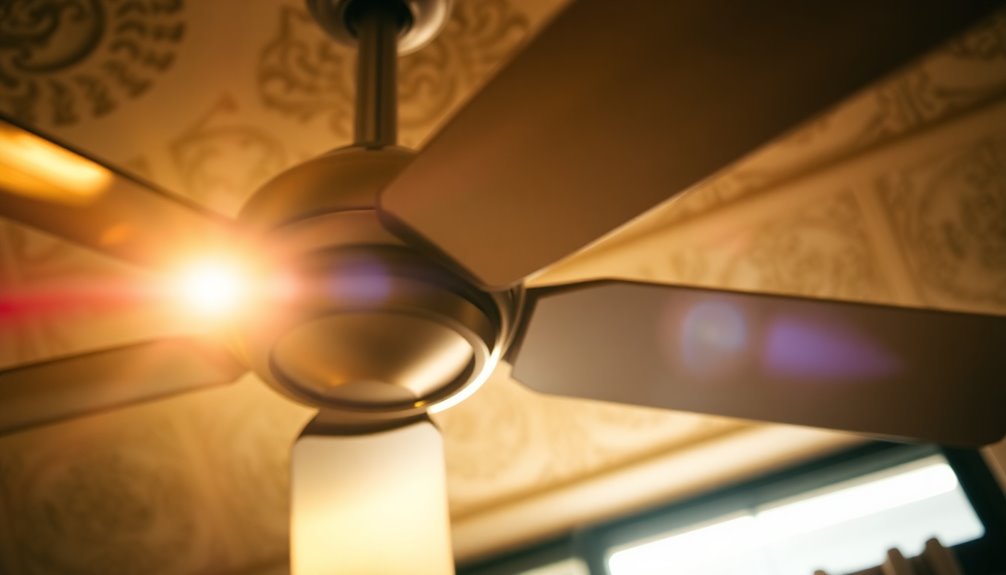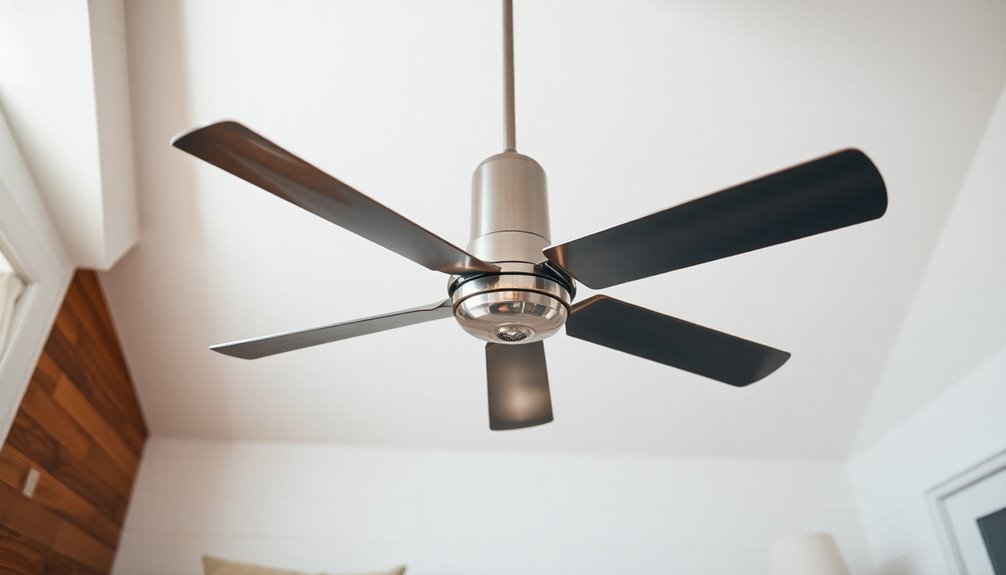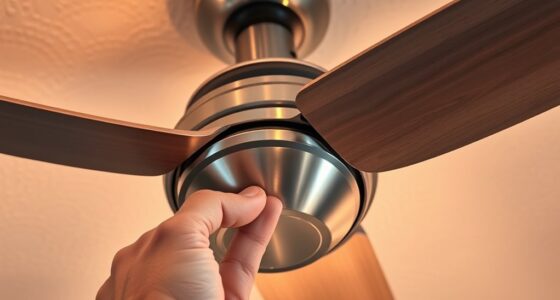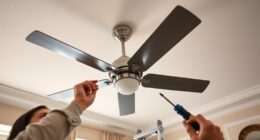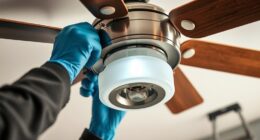If your ceiling fan's rattling, it's likely due to loose screws, unbalanced blades, or motor issues. Start by checking and tightening any loose bolts and screws in the fan assembly. Accumulated dirt on the blades can throw them off balance, causing vibrations. Misaligned blade brackets also disrupt airflow and create noise. Additionally, worn bearings may lead to unwanted rattling sounds. Regular maintenance can help prevent these problems. If the rattling persists after your checks, there might be a deeper issue at play. You might find more insights into effective solutions and maintenance tips just ahead.
Key Takeaways
- Loose screws or bolts in the fan assembly can cause vibrations and rattling noises during operation.
- Unbalanced fan blades due to misalignment, dirt buildup, or damaged blades contribute to rattling sounds.
- Accumulated debris on blades disrupts their balance, leading to increased noise levels.
- Worn-out or damaged motor bearings can create friction, resulting in persistent rattling.
- If rattling continues after basic checks, consider seeking professional help for further assessment.
Causes of Ceiling Fan Rattling

Have you ever wondered what might be causing that annoying rattling sound from your ceiling fan? Several factors could be at play.
First, loose screws or bolts in the fan assembly can lead to vibrations during operation, causing those frustrating rattling sounds. Check the blade brackets and mounting hardware to verify they're securely fastened.
Another common culprit is unbalanced fan blades. If one or more blades are misaligned or heavier due to dirt buildup, they can wobble and hit surrounding structures, creating noise.
Speaking of dirt, accumulated debris on the blades can disrupt their balance, further contributing to rattling issues.
Improper installation can also be a significant factor. If the fan canopy or downrod isn't mounted correctly, it can shake while in use, leading to unwanted sounds.
Finally, don't overlook worn-out or damaged bearings. They may create friction, resulting in a rattling sound as the fan operates.
Identifying these causes will help you tackle the issue effectively and enjoy a quieter, smoother ceiling fan experience.
Loose Screws and Fasteners

How often do you check the screws and fasteners on your ceiling fan? If you haven't inspected them lately, loose screws could be the culprit behind those annoying rattling noises. The vibrations from your ceiling fan's operation can cause these components to shift, creating that unwanted sound.
Make sure the blade brackets are securely fastened to the motor assembly. Each blade has screws at its base that need regular inspection to prevent rattling.
Don't forget about the downrod connection; if it's loose, it can contribute to wobbling and increase those rattling sounds.
Additionally, check the canopy screws, which secure the fan to the ceiling. If they're not tight, they can rattle against the ceiling surface, amplifying the noise.
Blade Imbalance Issues

If your ceiling fan rattles, blade imbalance might be the culprit.
This issue often stems from uneven weight distribution, misaligned brackets, or dirt buildup on the blades.
Recognizing the signs and addressing the imbalance can greatly improve your fan's performance and reduce that annoying noise.
Causes of Blade Imbalance
Blade imbalance can wreak havoc on your ceiling fan, leading to annoying rattling sounds and vibrations. This issue arises when the weight distribution across the fan blades is uneven.
One common cause is misaligned blade brackets, which can disrupt the proper angles of the blades, exacerbating noise and vibrations.
Another factor is the accumulation of dirt and debris on the blades, which adds extra weight and can lead to wobbling sounds. If your blades are damaged or warped, they won't maintain uniform airflow, resulting in increased vibrations and potential rattling noises.
To tackle these issues, using a blade balancing kit can be a game changer. This kit helps you identify and correct imbalance problems, allowing you to restore smooth operation and greatly reduce noise.
Regularly checking for dirt, ensuring your blade brackets are aligned, and inspecting for any damage can help prevent blade imbalance from occurring in the first place. By addressing these causes, you can enjoy a quieter, more efficient ceiling fan experience.
Signs of Imbalance
When your ceiling fan starts to rattle or vibrate excessively, it's often a telltale sign of blade imbalance. This issue arises when the weight distribution across the fan blades is uneven, leading to disruptive vibrations and rattling noises. Here are some common indicators of blade imbalance:
| Signs of Imbalance | Description |
|---|---|
| Excessive vibrations | Noticeable shaking while the fan operates. |
| Rattling noises | Sounds that vary with fan speed. |
| Misaligned blade brackets | Blades positioned at incorrect angles. |
| Accumulation of dirt and debris | Extra weight disrupting balance. |
Regular inspection is essential for maintaining your ceiling fan. Look for damage or warping of the blades, as these defects can exacerbate the imbalance and contribute to operational noise. Additionally, color accuracy is crucial in ensuring that any appliances, including fans, function smoothly and without interference. Misaligned blade brackets can alter the angle of the blades, while dirt and debris can add extra weight, intensifying the issue. If you suspect blade imbalance, consider using a blade balancing kit to identify and correct the problem, ensuring smoother operation and reducing those annoying rattling sounds. Additionally, regular maintenance can prevent dangerous situations related to ceiling fan operation.
Solutions for Balancing Blades
To effectively tackle blade imbalance issues, you can implement several straightforward solutions that restore your ceiling fan's functionality.
Start by inspecting and tightening blade screws; ensuring they're secure helps maintain even blade alignment, which is vital for preventing vibrations and rattling sounds.
Next, make sure to clean fan blades regularly. Dirt and debris can accumulate and disrupt weight distribution, leading to blade imbalance. A simple wipe-down can help restore balance and improve performance.
If you suspect more considerable imbalances, consider using a ceiling fan balancing kit. This kit allows you to add weights to specific blades or adjust their angles, which can correct imbalances effectively.
Lastly, check for misaligned blade brackets. Correcting these can notably reduce rattling and enhance the fan's quietness.
Motor and Bearing Problems

If your ceiling fan rattles, it might be due to motor issues or bearing problems.
Worn bearings can create friction, while dust buildup increases resistance, leading to noise.
To keep your fan running smoothly, regular maintenance and lubrication of the motor bearings are essential. Additionally, ensuring that your fan operates in a clean environment can help reduce air quality issues that contribute to dust accumulation.
Common Motor Issues
Ceiling fan rattling often stems from common motor issues, particularly problems with the motor and bearings. One major cause is worn motor windings, which can create vibrations that lead to a persistent rattling sound during operation.
If you notice loose or misaligned motor components, this can exacerbate noise issues, adding to the overall rattling.
Dust accumulation on motor bearings increases friction, ultimately causing grinding noises that contribute to the rattling sound. Another vital factor is the motor's capacitor; if it's faulty, the motor may struggle to operate correctly, resulting in abnormal noises.
To avoid these issues, regular inspection of the motor is essential. Make sure to check for signs of wear and tear, as neglecting this can lead to more significant problems.
Lubricating the motor bearings can help reduce friction and prevent the rattling sound caused by excessive wear. By staying proactive about maintenance, you can minimize disruptions and keep your ceiling fan running smoothly.
Bearing Maintenance Tips
Maintaining your ceiling fan's bearings is vital to prevent rattling and assure smooth operation. Start by regularly inspecting the motor bearings for any signs of wear or damage. Worn bearings can increase friction, leading to unwanted noise that contributes to rattling.
If you notice any unusual noises while the fan's running, it may indicate that the bearings are failing and need your immediate attention.
It's important to lubricate the bearings at least annually with the manufacturer's recommended oil. This practice helps reduce friction and guarantees smooth operation.
If the bearings are dirty, take the time to clean them gently to remove dust and debris. Buildup can negatively impact performance and lead to more rattling sounds.
Don't ignore any signs of damage. If you find that the bearings are indeed damaged or excessively worn, replace them promptly.
Neglecting to address these issues can worsen rattling and potentially lead to further motor problems. By following these bearing maintenance tips, you'll keep your ceiling fan running quietly and efficiently for years to come. Additionally, maintaining your fan's efficiency can lead to lower energy bills by reducing reliance on air conditioning.
Maintenance and Prevention Tips

Keeping your ceiling fan in top shape can help you avoid pesky rattling noises. Start by regularly inspecting and tightening all screws and bolts on the fan, including blade brackets and light fixtures. Loose components are often the culprits behind those annoying sounds. Regular maintenance is essential, just like top rated vacuums that are designed to perform reliably over time. Maintaining your fan can also be likened to using best lawn fertilizers that ensure your garden thrives effectively.
Don't forget to clean fan blades and the motor housing periodically—dust and debris can disrupt balance and lead to noise. Additionally, consider integrating smart home devices that can help monitor and control your ceiling fan for optimal performance.
Lubricating the motor bearings annually with the appropriate fan oil is crucial to reduce friction and prevent grinding or squeaking sounds.
Additionally, utilizing a blade balancing kit can guarantee even weight distribution across the blades, helping to mitigate wobbling and rattling noises. Regular maintenance can enhance your fan's performance and longevity, just like vacuums with HEPA filters that improve indoor air quality by trapping allergens effectively.
When to Call a Professional

If you're still hearing rattling from your fan after tightening screws and checking for loose parts, it's time to reflect on calling a professional. Persistent rattling can indicate deeper mechanical issues that require expert intervention. If you hear unusual or escalating noises, like grinding, it often signals problems with the motor or bearings, necessitating a professional assessment.
It's also important to evaluate the installation. If your fan is improperly installed, and you lack the skills to fix it, consulting a professional guarantees it's reinstalled safely. Electrical issues, such as flickering lights or buzzing sounds, should prompt an immediate call to a licensed electrician to prevent potential hazards.
Here's a quick reference table to help you decide when to call for help:
| Signs of Trouble | Recommended Action | Possible Issues |
|---|---|---|
| Persistent rattling | Call a professional | Mechanical issues |
| Unusual grinding noises | Seek expert intervention | Failing motor or bearings |
| Flickering lights | Contact a licensed electrician | Electrical issues |
Frequently Asked Questions
How Do I Stop My Ceiling Fan From Rattling?
To stop your ceiling fan from rattling, start by tightening all screws and bolts on the fan blades, motor, and mounting bracket.
Next, check the blades for balance and adjust them if needed. Look for loose screws in the light fixture and canopy.
Clean the blades and motor bearings to eliminate dust buildup, and guarantee the fan is securely mounted to the ceiling.
These steps should help eliminate any annoying rattling sounds.
Why Does My Fan Rattle so Much?
You might wonder why your fan rattles so much.
Well, it could be due to loose screws or unbalanced blades. If the fan isn't installed properly, that can add to the noise too.
Check for dirt buildup or wear on the bearings, as these can create vibrations.
Ultimately, electrical issues might be at play.
Addressing these factors can help you enjoy a quieter, smoother fan experience.
How Do You Fix a Ceiling Fan That Wobbles and Makes Noise?
To fix a ceiling fan that wobbles and makes noise, start by tightening all screws on the blades, motor assembly, and light kit.
Check the blades for damage or warping, replacing any that are unbalanced.
Use a blade balancing kit to add weights where needed.
Clean the blades and motor housing to remove dust, and lubricate the motor bearings to reduce friction.
These steps will help restore smooth operation and eliminate noise.
Should I Be Worried if My Fan Is Making Noise?
If your fan's making noise, you should definitely pay attention.
While some sounds can be normal, consistent or loud noises often indicate underlying issues. You might've loose screws, unbalanced blades, or worn bearings.
Ignoring these problems can lead to more damage or even safety hazards.
It's best to inspect the fan and address any concerns promptly to guarantee it operates safely and efficiently for years to come.
Conclusion
In the dance of comfort and chaos, a rattling ceiling fan disrupts the harmony of your home. While loose screws and imbalanced blades may seem trivial, they can transform a soothing breeze into an annoying clatter. By addressing these issues promptly, you restore peace and prevent further complications. Embrace regular maintenance as your ally; it keeps tranquility in the air. Sometimes, it's the smallest things that can either amplify the calm or amplify the noise. Choose wisely.
